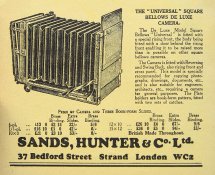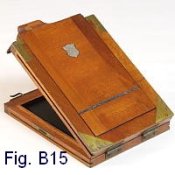Ian Grant
Subscriber
I wasn't thinking of a roll film conversion in your case, it was the only real option with my Quarter plate camera as film's only available as part of Ilfords ULF order and expensive, plus I have no plate holder 
You're right a spacers possibly all that's needed with your wooden holders, I'm more used to the German 9x12 metal plate holders that need a film insert. The only thing you may have to watch is the nominal 5x4 film size is a touch less than the plate size, but you may have no problem.
I'll copy what I have about the Sands, Hunter cameras and let you have the info as jpegs. It's interesting that the company still sold a tailboard camera 45 years later in 1928. I collect BJP Almanacs but pre WWII copies tend to be expensive, pre WWI even more so. The Tailboard camera & a field camera are in the 1928 Almanac but gone by 1935 but 35mm is beginning to appear with fast f1.5 lenses, there's better more modern Rolleiflex's and Europe made faster switch to small formats than the US.
When I'm back in the UK next month I'll be looking for plate holders for my quarter plate camera, (I may have also bought a half plate camera), let me have some photo's and dimensions in case just I find some holders that may fit your camera. I'll be liaising with a friend who deals in cameras and will ask him as well.
Ian

You're right a spacers possibly all that's needed with your wooden holders, I'm more used to the German 9x12 metal plate holders that need a film insert. The only thing you may have to watch is the nominal 5x4 film size is a touch less than the plate size, but you may have no problem.
I'll copy what I have about the Sands, Hunter cameras and let you have the info as jpegs. It's interesting that the company still sold a tailboard camera 45 years later in 1928. I collect BJP Almanacs but pre WWII copies tend to be expensive, pre WWI even more so. The Tailboard camera & a field camera are in the 1928 Almanac but gone by 1935 but 35mm is beginning to appear with fast f1.5 lenses, there's better more modern Rolleiflex's and Europe made faster switch to small formats than the US.
When I'm back in the UK next month I'll be looking for plate holders for my quarter plate camera, (I may have also bought a half plate camera), let me have some photo's and dimensions in case just I find some holders that may fit your camera. I'll be liaising with a friend who deals in cameras and will ask him as well.
Ian
















